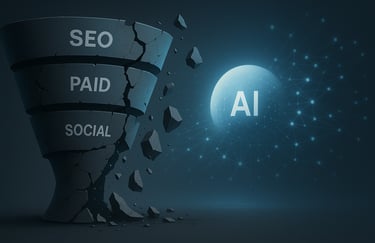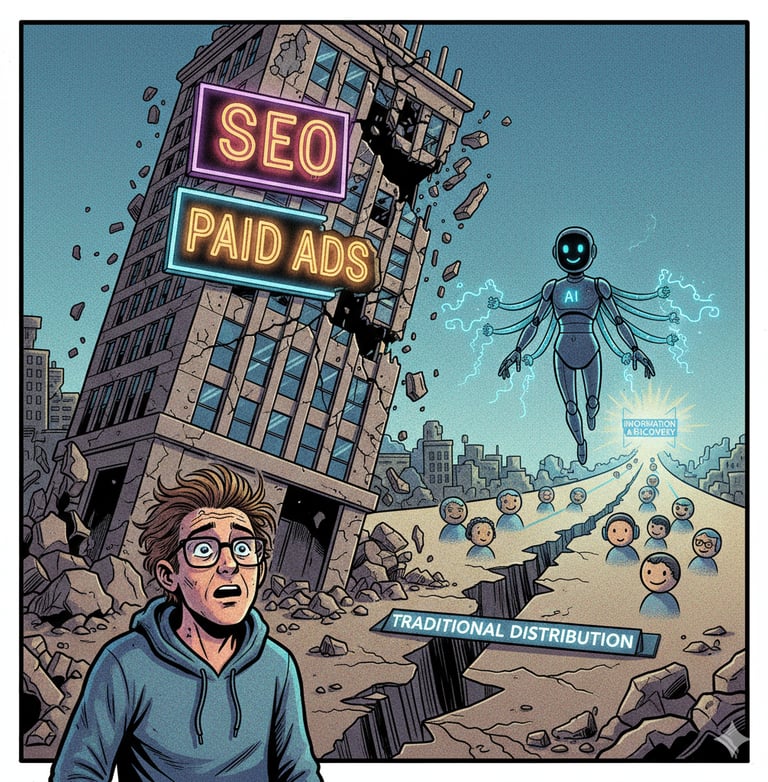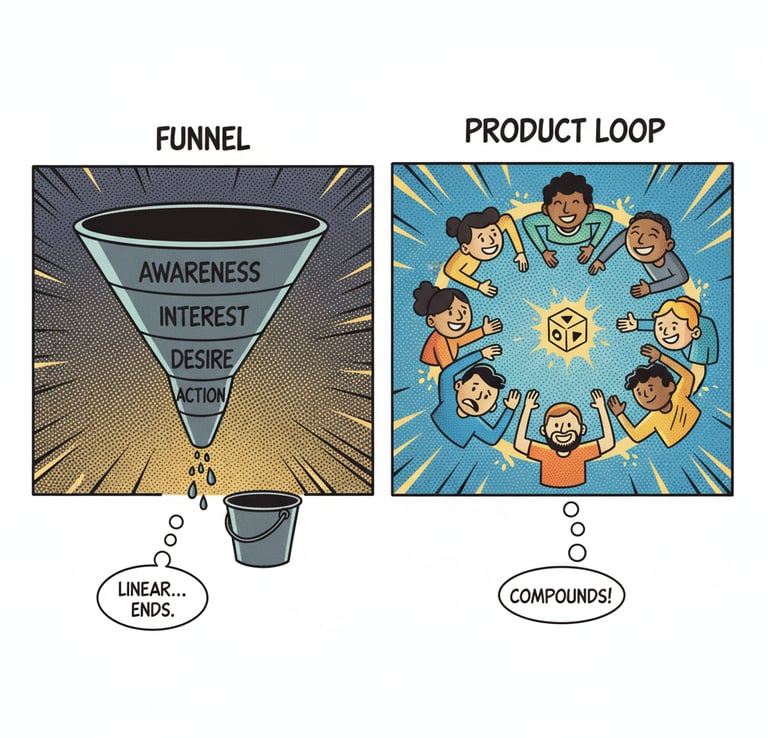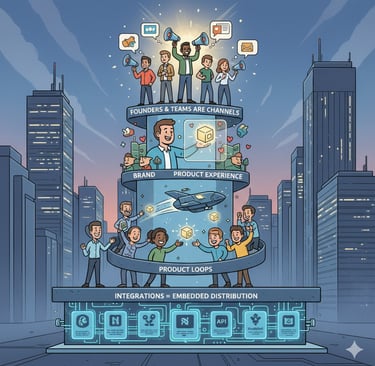How Do You Build Distribution in a World Where AI Owns Attention?
SAASGROWTH
11/7/20255 min read


Key Takeaways
AI has disrupted traditional growth channels like SEO, social, and paid — forcing founders to rethink distribution.
Trust, speed, and embedded systems now matter more than traffic and impressions.
Winning companies bake distribution into their product, brand, and people.
Growth loops, ecosystem integrations, and founder-led channels define the new GTM model.
The future belongs to AI-native, velocity-driven organizations that can build and ship fast.
The Collapse Nobody Wants to Admit
If your organic traffic is slowly declining, it’s not because your SEO got worse — it’s because AI just end your distribution.
It didn’t roll out an update or warn anyone.
It simply changed how people discover products and information.
According to Gartner, search volume will drop by 25% by 2026 as AI assistants like ChatGPT and Perplexity become the new default for discovery.
People aren’t Googling “best CRM for startups” anymore — they’re asking AI directly.
AI didn’t just disrupt search.
It disrupted discovery itself.
And if your GTM still depends on SEO or ads, you’re building a skyscraper on a fault line
The End of Traditional Distribution
For years, growth meant three things: SEO, paid ads, and social media.
That world doesn’t exist anymore.
SEO is collapsing. ChatGPT and Perplexity now answer queries directly. “Zero-click searches” dominate.
Social reach is throttled. LinkedIn, X, and Instagram prioritize engagement, not link clicks. Post a link, and your visibility plummets.
Paid ads are expensive. CPCs are rising while buyer trust keeps dropping.
The internet’s core growth model — links → clicks → funnels — is breaking down.
And those who win won’t cling to it.
They’ll rebuild distribution from the ground up.


AI didn’t break marketing — it changed buyer behaviour
AI didn’t just remove your traffic. It rewired how buyers think.
Before, marketing was about visibility.
Now, it’s about trust.
Buyers don’t browse — they ask.
They trust models, founders, and peers, not marketing copy.
They don’t care about your keyword ranking. They care about credibility.
So, distribution today isn’t about where you show up — it’s about who delivers you.
AI removed information friction.
Now, trust is your new distribution currency.
The New Distribution Stack (2025 and Beyond)
Great products die slow deaths without distribution. But bad products with great distribution become billion-dollar companies.
You can’t buy your way back into relevance.
You have to build distribution into your product, your brand, and your people.
Here’s what that stack looks like 👇
1. Product Loops > Funnels
Funnels are linear. Loops compound.
A funnel ends when spending stops.
A loop grows because users feed it.
Dropbox mastered this: “Give storage, get storage.”
That simple loop powered their early growth — driving millions of signups through user referrals.
Ask yourself:
“What action in my product naturally attracts another user?”
That’s your growth loop.
Build it. Measure it. Scale it.


2. Velocity Is the New Moat
You can’t outspend every competitor — but you can out-ship them.
AI-enabled tools like Clay, n8n, and Zapier let small teams automate enrichment, workflows, and experimentation — compressing what once took weeks into days.
Velocity compounds.
Each release becomes a data point that fuels smarter product and GTM decisions.
Speed isn’t a luxury anymore — it’s a survival strategy
3. Brand = Product Experience
Brand isn’t just identity.
It’s how your product feels.
In a world where features can be copied overnight, emotion and user experience are your last defensible moats.
Every interaction — from onboarding to microcopy — shapes how your users perceive you.
You can’t out-feature competitors, but you can out-feel them.
Design moments that delight, surprise, and build trust
4. Integrations = Embedded Distribution
You don’t always need new channels.
Sometimes, you just need better neighbors.
Integrate your product into where your users already live — Slack, Notion, HubSpot, Salesforce, or emerging ecosystems like OpenAI’s GPT Store.
That’s not marketing – it’s embedded distribution.
When your product becomes part of their workflow, you’re not “acquired.”
You’re adopted.
Integrations should be easy to set up and deliver instant value.
5. Founders and Teams Are Channels
People trust people.
When founders, PMs, and teams publish useful, authentic content, they create organic discovery that algorithms can’t suppress.
This isn’t about vanity metrics.
It’s about pipeline positioning.
Make visibility a shared team responsibility.
When everyone builds in public, you multiply reach and credibility — without paying for it.


How to Rebuild Your Distribution Engine
Here’s your six-step blueprint for 2025:
Audit dependencies.
Identify where 70–80% of your pipeline comes from. If it’s one channel, diversify.Design your loop.
Map the user action that can produce another user or referral. Instrument and measure it.Build AI-native velocity.
Automate repetitive tasks — testing, content, outreach — to free up speed and creativity.Embed into ecosystems.
Integrate where your ICP already works. Don’t fight for attention; live where it exists.Turn contributors into creators.
Encourage every team member to publish insights, not marketing fluff.Treat product usage as marketing.
Give users quick value that makes them want to share it.
Proof It Works
Modern winners demonstrate these principles in practice:
Dropbox: 60% of new users from built-in referral loops.
Figma: Brand and growth powered by collaboration.
Notion: Ecosystem of creators and templates fueling scale.
Lovable: Word-of-mouth loop through magical user experiences.
All of them built distribution inside the product, not around it.
What this means for founders
The era of “buy traffic → hope for conversions” is over as a standalone strategy. Leaders must assume responsibility for distribution: they own the systemic design of how their product is discovered, adopted, and recommended.
Focus on measurable loops, incremental delivery speed, product experience, and on embedding credibility through people and partners. These are the elements that compound across months and years.
Closing thoughts
Funnels are not entirely dead, but they are insufficient on their own. The future of GTM is built from compound systems: product loops, velocity, integration, and human trust.
Stop allocating your highest confidence to fragile channels. Invest in systems that create predictable, compounding acquisition and retention.
💬 Book a Strategy Session
→ Let’s turn your product into your most powerful distribution channel.
FAQs
1. How does AI affect SEO strategy for B2B startups in 2025?
AI is changing how users discover information. Instead of relying solely on Google search, buyers now ask AI assistants for recommendations. B2B startups should focus on AI optimization (AIO) — ensuring brand visibility in AI-generated answers, not just traditional SERPs.
2. What are the best ecosystem integrations for early-stage SaaS growth?
Early SaaS teams can start with lightweight integrations into Slack, Notion, HubSpot, or the OpenAI GPT Store. These create embedded visibility where your users already work, helping you grow without large ad spend.
3. How can startups measure product-led growth loops effectively?
Track loop input (user actions), conversion (invites or shares that convert), and loop yield (new users or revenue). Tools like Mixpanel or Amplitude make it easy to measure loop velocity and retention impact — core metrics in a product-led growth strategy.
4. How can companies increase product velocity without sacrificing quality?
Adopt AI-native workflows — automate QA, release pipelines, and data analysis using tools like Clay, n8n, or Zapier. Pair fast iteration with feature flags and rollback systems to maintain product quality while shipping faster.
5. How can B2B founders rebuild their distribution model in the AI era?
Focus on trust, speed, and embedded presence. Build growth loops into your product, integrate into existing ecosystems, and empower your team to share learnings publicly. These compounding systems replace the fragile reach of traditional SEO or paid ads.
